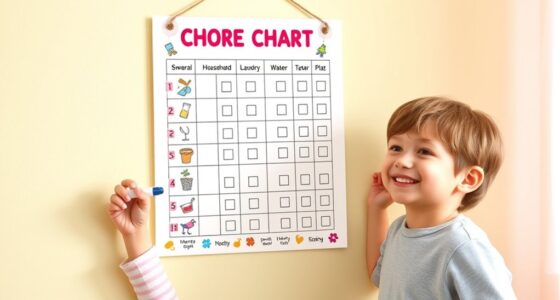Family meetings are a powerful way to strengthen bonds, improve communication, and address issues quickly—all in just 15 minutes. By keeping meetings focused, setting a regular schedule, and following a simple agenda, you create a safe space where everyone feels heard. Use active listening, positive reinforcement, and calm problem-solving to foster ongoing respect and connection. Want to discover how to run effective family meetings that truly make a difference? Keep exploring to learn more.
Key Takeaways
- Family meetings build trust, improve communication, and resolve issues early, strengthening family bonds in just 15 minutes.
- Keep meetings focused with a simple agenda and set a regular weekly time for consistency.
- Foster an open, respectful environment by modeling active listening and encouraging everyone to share.
- Incorporate enjoyable elements like scenic views or local shops to make meetings engaging and inviting.
- Use calm, positive communication strategies to reinforce good behavior and maintain productive, relationship-building discussions.

Have you ever wondered how some families seem to stay connected and handle conflicts effortlessly? It’s often because they practice simple yet powerful tools like family meetings. These meetings aren’t about long, formal gatherings—they’re quick, intentional check-ins that build trust and understanding. To make them effective, you need to develop solid parenting strategies and sharpen your communication skills. When you approach family meetings with a clear plan, they become a powerful way to foster connection and resolve issues before they escalate.
The key is to keep these meetings focused and manageable—around 15 minutes is ideal. You might start by setting a specific time each week, ensuring everyone knows it’s a priority. During this time, everyone gets a chance to speak, listen, and share updates. It’s important that you create a safe space where children feel comfortable expressing themselves without fear of judgment. As a parent, your role is to model good communication skills—active listening, maintaining eye contact, and validating feelings—even when disagreements arise. This establishes a pattern that children will emulate in other areas of life.
Using effective parenting strategies during these meetings helps keep things productive. For example, you can set a simple agenda, like discussing upcoming events, celebrating achievements, or addressing concerns. When conflicts come up, approach them calmly, asking questions like, “How can we solve this together?” This encourages problem-solving and cooperation. It’s also helpful to reinforce positive behavior by highlighting what went well, rather than only focusing on negatives. Over time, this reinforces the idea that family meetings are a safe and constructive way to work through challenges.
Another important aspect is consistency. When you stick to your meeting routine, your children learn that their voice matters and that solutions are a team effort. Keep the tone respectful and encouraging, so everyone feels heard. Remember, the goal isn’t to fix everything in one session but to foster ongoing communication and mutual respect. As you become more comfortable with these meetings, you’ll notice your family’s ability to handle conflicts improves naturally. Your enhanced communication skills, combined with thoughtful parenting strategies, lay the foundation for healthier relationships.
In addition, understanding the importance of setting a positive environment—such as incorporating scenic views and charming local shops—can make these meetings more inviting and enjoyable for everyone involved. In the end, family meetings are a simple yet powerful tool that, when run in just 15 minutes, can transform your family’s dynamics. They help everyone stay connected, express themselves openly, and resolve issues quickly. With a little preparation and a commitment to consistent, respectful dialogue, you’ll discover the secret power behind these meetings—stronger bonds that last a lifetime.
Frequently Asked Questions
How Do I Handle Disagreements During Quick Family Meetings?
When disagreements pop up during quick family meetings, focus on conflict resolution by encouraging emotional expression. Let everyone share their feelings calmly and listen actively. Set clear boundaries to keep discussions respectful, and steer the conversation toward finding a solution rather than assigning blame. By fostering open communication and understanding, you can handle disagreements effectively and keep the meeting productive for everyone involved.
What Age Is Best to Start Family Meetings?
You might think there’s a perfect age for family meetings, but it’s really about developmental readiness. Starting as early as age three can build communication skills, yet older kids grasp responsibilities better. Focus on age-appropriate topics and keep sessions short. When children are ready, even young ones can contribute; it’s about fostering connection and respect, regardless of age. Adjust as your family grows, making meetings a natural part of your routine.
How Can I Ensure Equal Participation From All Family Members?
To guarantee equal participation and balance in family meetings, create a safe space where everyone feels heard. Use a talking stick or set time limits to give each person an equal voice. Encourage quieter members by asking specific questions and acknowledge all contributions. Keep the atmosphere positive and respectful, so everyone feels comfortable sharing. Regularly rotate roles to promote participation and make sure no one dominates the conversation.
What Tools or Materials Are Needed for a 15-Minute Meeting?
For a quick 15-minute meeting, you’ll need a simple agenda and some basic materials. Prepare your agenda beforehand to set clear topics and goals. Gather materials like a notepad, pen, and any relevant documents or charts. This helps keep the meeting focused and efficient. With these tools, you can easily facilitate a productive discussion, guarantee everyone stays on track, and make the most of your family meeting time.
How Often Should Family Meetings Be Held for Maximum Benefit?
You should aim for a consistent family meeting frequency, such as weekly or biweekly, to build routine and trust. For ideal scheduling, pick a day and time that work for everyone, making it easy to stick to the plan. Regular meetings keep communication open, resolve issues early, and strengthen family bonds. Adjust the frequency as needed, but staying consistent maximizes the benefits and keeps everyone engaged.
Conclusion
Family meetings hold genuine power to strengthen bonds and resolve issues quickly. Some say they’re just chores, but research shows they boost communication and trust, leading to happier, more connected families. When you run yours in just 15 minutes, you tap into that secret strength—fostering understanding and teamwork without taking up much time. So, give it a try; your family’s unity might just surprise you, proving that even short meetings can create lasting change.










